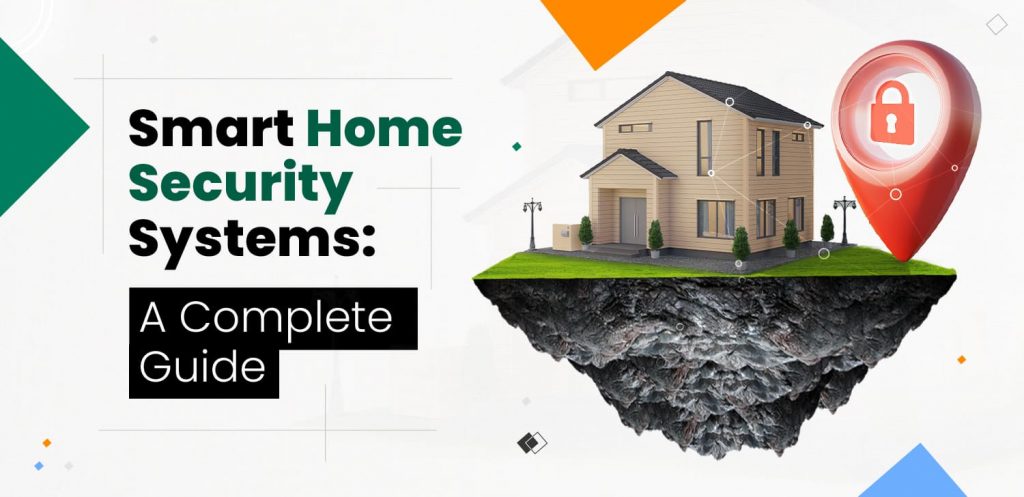
Smart technology has recently gained popularity among homeowners and doesn’t seem to lose any of its charms in the coming years.
Nowadays, smart home security systems are the most up-to-date method of enhancing your home security. The most current smart home security systems are safer, easier to use, and handier than ever compared to older, more restricted security systems.
If you are new to smart home technology. Don’t worry! We have you covered.
In this blog, we’ll discuss the features and advantages of a smart home security system. But, firstly, let’s quickly discuss,
Smart Home Security Systems: What & How it Works?
Smart home security systems remotely monitor your house every day of the year, from proximity and motion sensors to smart surveillance cameras. Watch online through a live feed, get alerts when motion is spotted, and set off alarms manually or automatically.
Once smart home security systems are connected, you’ll be able to view the status of each security system component, including the alarm system, access control, and CCTV. Your smartphone will receive a signal when a sensor on your smart home security system triggers, informing you whether an alarm has been activated or motion has been detected, signaling the detection of an intruder. Following notification, you will be able to take the appropriate action, such as calling the authorities or turning off the alarm, if needed. If your home has CCTV, you may also use your smartphone to see live footage to confirm an invader or break-in.
Moving forward, let’s check,
Types of IoT-Based Home Security Systems
Listed below are some top types of IoT-based home security systems. Take a look!
a. Biometric Systems
These days, biometric lock systems are widely used. With a fingerprint, users can access the property. Because of their all-around security, biometric locks are becoming more and more popular.
b. Video Doorbell
When a guest rings the doorbell or if a motion detector picks up movement near the device, the device can send live video to your smartphone. You can see recorded footage from the doorbell at a later time as well. Additionally, you can use your smartphone to communicate with the visitor as a result. When you are not at home, it is convenient to contact courier service personnel.
c. Smart Camera
Smart Cameras are important for home security. Internet-connected cameras are wireless, and you can easily access them from any place.
d. Smoke Sensors
Smoke detectors are essential in every home. These detectors are set up to notify you whenever the amount of CO in your home is exceptionally high.
e. Motion Sensors
Motion sensors are essential for maintaining your home’s security. Any unusual activity in or near your home can be detected by these IoT devices and reported to you. They may react to 2D or 3D gestures and can detect motion or vibration.
Moving ahead, let’s talk about,
Benefits of Using Smart Home Security Systems!
What are the top benefits of smart home security systems? Is it worth the hype?
Let’s find out!
1. Real-time Alerts
You can configure an IoT-based home security system to notify you if anything goes wrong, which is one of its top advantages. You can customize the notifications you receive based on the features of your system.
The systems can only detect motion and direct contact and can also detect smoke. The best thing is if you can’t physically hit the call button, you can program the IoT-based home security system to automatically alert local authorities to ensure that aid is on the way.
2. Remote Access
A home security system enables you to keep an eye on your family and pets if you are a perpetual workaholic who worries about them.
You can view what’s happening at home using security cameras by connecting the IoT-based home security system to an app on your smartphone. This would enable you to seek assistance right away if something were to happen to an older person or a pet who is left alone at home.
3. Automation
The ease with which a home security system may be integrated with other smart home appliances is one of its most attractive features. This category now includes smart thermostats and smart lights, and door locks. Through your app on your smartphone and your smart security system, all may be readily connected and watched. You might designate a mode to turn on the air conditioning, the TV, or even Alexa to give you the latest information.
Also Read: IoT-based Home Automation Development: What’s in it for Businesses?
4. Cost-effective
Home insurance can be pricey because the considerable expenses can add up to large rates.
However, if you invest in an IoT-based home security system that includes cameras, burglar alarms, smoke detectors, and more, your house will be viewed as having a low risk by insurance providers.
As you’ve seen, the benefits of the smart home security system. Now, let’s move forward and discuss,
Top Must-Have Features of Smart Home Security Systems!
Here are the essential features of a smart home security system you’ll need for the optimal benefit if you’ve decided to build a custom system for yourself.
Energy Consumption Monitor
There are several advantages to having an IoT-based smart home security system that monitors and optimizes energy use. It not only makes your usual usage more sustainable, but its effective modeling will also enable you to spend less money on energy.
Integration
It can become tiresome at times to navigate through apps. You are lucky that having a home security system with AI surveillance software allows you to combine it with Alexa, Google, and Siri functionalities, enabling you to arm and disable the system using voice recognition on the app.
Smoke Detection
Your safety can significantly change if smoke and fire are detected promptly by having this feature. In case of a fire, the system will immediately notify you and activate sprinklers to stop the spread. You can use the warnings to assist you in leaving the area and finding safety until the rescuers or other appropriate authorities have dealt with the fire or smoke issues.
Motion Detection
One of the foundational security components and a must-have feature is motion detection. Motion sensors should detect if someone is inside your house who shouldn’t be there. They monitor the interior of the house’s spaces and identify movement.
Real-time Alerts
With this feature, if someone opens your door or window while your security system is on, the alarm will go off automatically, or you’ll get a notification right away on your smartphone. Frequently, the smart home security system will also let you know which window or door is open. If you often forget to shut your windows and doors before leaving your house, this feature will come in handy.
Complete Control
Your smart home security system can be managed remotely, allowing you to control and monitor your place even when you’re not at home. You may control and turn on/off your home security with this feature, regardless of the time, day, or location.
How to Develop Your Own Smart Home Security System?
Below are some steps that you must consider if you want to build an efficient IoT-based home security system.
1. Choose Hardware
Building a reliable hardware solution is becoming the norm for most projects due to the growth of the IoT. A well-functioning IoT-based smart home security system may depend on reliable connectivity, but solid hardware is still necessary. The development process can be sped up. A finished product that performs all the required functions can be delivered by carefully selecting your hardware and integrating a program that can swiftly supply seamless upgrades.
2. Build a Prototype
Although creating a prototype can take some time, it is time well spent. You’ll learn the essential requirements for completing an IoT project before deployment when changes are simpler. You can identify any technological or skill shortages by creating a prototype while you have more time to carry out a thorough talent hunt.
3. Hire IoT Developers
Building an IoT solution is difficult. You must hire IoT developers if you want your product to be successful. But, before hiring IoT developers, you need to consider some aspects like:
- Developer’s expertise
- Check their portfolio
- Communication skills
- Check reviews or testimonials
- Check their hiring models
4. Do Extensive Testing
You must put your custom IoT-based home security system through a thorough testing procedure. Testing custom IoT solution devices entails determining the device’s performance in terms of functional parameters, service interoperability, security, networks, processors, OS, platforms, and standards.
Conclusion
The IoT is a technology that is always evolving and has raised the bar for home security. Commercial buildings can also have smart security systems installed to provide smart security, so it is not just limited to residential homes.
Make sure you don’t fall behind and miss out on the advantages that IoT-based home security systems have to offer as their popularity continues to rise. Installing smart gadgets on your property can improve safety, lower long-term costs, and make regular tasks more convenient.
You require top-tier IoT development services to partner with if you want to maximize the impact and efficacy of an IoT-based smart home security system. Make sure that the company should be able to develop a thorough, strategic roadmap that gets you from idea to completion. From assessing infrastructure and risks to designing smart home security solutions, our skilled IoT developers handle it all. Request a FREE quote now.






